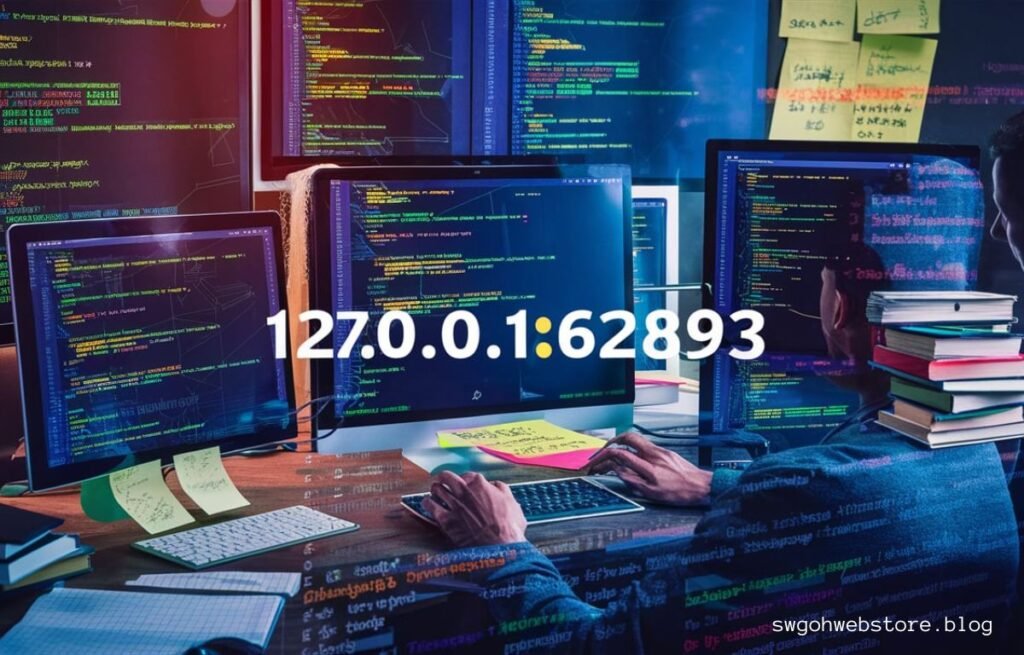In the world of web development and networking, encountering the code 127.0.0.1:62893 can be both puzzling and crucial. This guide aims to demystify its meaning, explore its functionalities, address common errors, and provide practical solutions for developers.
What is 127.0.0.1:62893?
127.0.0.1:62893 is a specific combination of an IP address and a port number that holds significant importance in networking and web development contexts. Here’s a detailed exploration of its meaning and functionality:
Understanding 127.0.0.1 and Port 62893
127.0.0.1 (localhost): This IP address is reserved for the loopback interface of your own computer. When an application uses 127.0.0.1 as its destination address, it communicates internally with itself, bypassing the need for external network connections. This is essential for local testing and development scenarios, allowing developers to simulate real-world environments without going online.
62893 (port number): Ports are like endpoints that applications use to send and receive data. Port 62893, while not as commonly used as standard ports, serves specific purposes such as facilitating communication with services like Memcached, a popular caching system in web development.
Benefits and Applications
Development and Testing: Developers rely on 127.0.0.1:62893 extensively during software development phases. It provides a controlled environment for debugging applications without impacting live systems or requiring internet access.
Network Understanding: Working with localhost and port numbers helps developers grasp fundamental networking concepts such as TCP/IP communication and client-server architecture.
Security and Isolation: By using localhost, developers can isolate development environments from external threats. Monitoring activities on port 62893 aids in identifying and mitigating potential security risks before deployment.
Common Use Cases
Debugging Tools: Many development tools, including integrated development environments (IDEs) like Visual Studio Code, utilize 127.0.0.1:62893 to connect debuggers to local applications for real-time debugging and troubleshooting.
Local Servers: Web servers and other services running on localhost (127.0.0.1) can be configured to listen on specific ports like 62893, allowing developers to test server-side logic and functionality in a controlled setting.
Security Considerations
Public Exposure: Exposing port 62893 to the internet can pose security risks, especially if vulnerable services like Memcached are running on this port. It could potentially lead to unauthorized access or exploitation by malicious actors.
Benefits of Using 127.0.0.1:62893

Using 127.0.0.1:62893 offers several key benefits for developers and network administrators alike, contributing significantly to efficient development practices and enhanced security measures. Here’s a detailed look at its advantages:
Local Development Environment
127.0.0.1 serves as the localhost IP address, allowing developers to run and test applications locally without needing an internet connection. Port 62893 specifically facilitates this internal communication, enabling developers to simulate real-world scenarios within a controlled environment.
Testing and Debugging
One of the primary advantages of using 127.0.0.1:62893 is its role in testing and debugging applications. Developers can deploy and troubleshoot software on their own machines without impacting external servers or systems. This setup accelerates the debugging process and ensures that applications function correctly before deployment.
Also Read: Exploring Anime:doqj3fxnevs= cat
Network Understanding
Working with 127.0.0.1:62893 helps developers gain a deeper understanding of network protocols and client-server communication. It allows them to experiment with different configurations and test interactions between components within a secure and isolated environment.
Enhanced Security
Using 127.0.0.1:62893 for local development enhances security by minimizing exposure to external threats. Applications and services running on localhost are shielded from unauthorized access attempts originating from the internet, reducing the risk of cyber attacks and data breaches.
Isolated Environment
Deploying applications on 127.0.0.1:62893 creates an isolated environment where developers can safely test new features and updates without affecting live systems. This isolation prevents conflicts with existing applications and ensures that changes can be thoroughly evaluated before deployment.
Efficient Debugging Tools Integration
Many debugging tools and integrated development environments (IDEs) utilize 127.0.0.1:62893 to connect to local applications for real-time debugging. This seamless integration streamlines the debugging process, allowing developers to identify and resolve issues promptly.
Flexibility in Application Configuration
Port 62893 offers flexibility in configuring and managing applications. Developers can allocate specific ports for different services or components, optimizing resource allocation and ensuring efficient application performance.
Educational Purposes
For students and newcomers to networking and development, experimenting with 127.0.0.1:62893 provides hands-on experience in understanding how applications communicate locally. It serves as a practical learning tool for grasping fundamental concepts in software development and network administration.
How Does 127.0.0.1:62893 Work?

Understanding how 127.0.0.1:62893 functions is crucial for developers navigating local development environments and troubleshooting network-related issues effectively. Here’s a comprehensive breakdown of its workings:
Localhost Concept
127.0.0.1: This IP address is commonly referred to as localhost. It represents the local loopback interface of the computer you are using. When an application communicates with 127.0.0.1, it essentially sends data to itself. This is useful for testing and developing applications locally without needing an internet connection.
Port Number (62893)
Port: Ports are virtual endpoints through which applications send and receive data. Port 62893 is a specific port number on your local machine. Each port number is associated with different services or applications. In this case, 62893 might be used by a specific service or application running locally, such as a debugging tool or a server instance.
Working Mechanism
Internal Communication: When an application on your computer wants to interact with another process or service locally, it specifies 127.0.0.1 (localhost) as the destination IP address and 62893 as the port number. This indicates that the data should remain within the local machine and not be routed over the network.
Routing Data: The operating system’s networking stack recognizes that data addressed to 127.0.0.1:62893 should be directed internally. It routes the data to the specified port number on the same machine where the application is running.
Use Cases
Development and Testing: Developers use 127.0.0.1:62893 extensively during software development to test applications locally. It allows them to simulate different scenarios and debug issues without affecting external servers or systems.
Debugging Tools: Many debugging tools and integrated development environments (IDEs) utilize 127.0.0.1:62893 to connect to local applications for debugging purposes. This setup enables developers to inspect variables, step through code, and diagnose issues in real-time.
Security Considerations
Local Isolation: Using 127.0.0.1:62893 helps in creating a secure and isolated environment for development. Applications running on localhost are shielded from external threats, minimizing the risk of unauthorized access or attacks.
Flexibility and Efficiency
Configurability: Developers can configure applications to listen on specific ports like 62893, allowing for flexible management of services and resources on their local machines.
Also Read:The Enduring Charm of kawaii:p1ifmjgpipg= cat
Is It Safe to Expose Port 62893 Publicly?
Exposing port 62893 publicly is generally not considered safe due to several security risks associated with it. Here’s a detailed explanation of why it’s advisable to keep port 62893 restricted to local use:
Security Risks of Exposing Port 62893 Publicly
Vulnerability Exploitation:
If a service or application on port 62893, such as Memcached or any other custom service, has security vulnerabilities, exposing it to the public internet increases the likelihood of exploitation. Hackers can exploit these vulnerabilities to gain unauthorized access or execute malicious activities.
Denial-of-Service (DoS) Attacks:
Publicly exposing port 62893 makes it susceptible to DoS attacks where malicious actors flood the port with excessive requests, overwhelming the system’s resources. This can lead to service disruptions or even system crashes.
Unauthorized Access:
Anyone with internet access can attempt to connect to port 62893 if it’s exposed publicly. Without proper security measures, this could result in unauthorized access to sensitive data or services running on that port.
Data Breaches:
Exposing port 62893 increases the risk of potential data breaches, especially if the service running on that port involves handling sensitive information. Malicious actors can exploit vulnerabilities to steal data or compromise the integrity of the system.
Best Practices and Mitigation Strategies
To mitigate the risks associated with port 62893:
Use Firewall Rules: Configure firewall settings to block external access to port 62893. Limit access to only trusted networks or IP addresses if remote access is necessary.
Implement Authentication and Encryption: If remote access is required, ensure that strong authentication mechanisms (e.g., SSH keys, VPN) and encryption (e.g., TLS) are implemented to secure communications.
Regular Updates and Patching: Keep the software and services running on port 62893 up-to-date with the latest security patches and updates to mitigate known vulnerabilities.
Network Monitoring: Monitor network traffic and activities on port 62893 using intrusion detection systems (IDS) or network monitoring tools. Detect and respond to any suspicious or unauthorized access attempts promptly.
Resolving the “Disconnected from the Target VM, Address: 127.0.0.1:62893” Error

Encountering the “Disconnected from the Target VM, Address: 127.0.0.1:62893” error is a common occurrence for developers using debugging tools or integrated development environments (IDEs) like Visual Studio Code. This error typically indicates a connection issue between the debugger and the application running on localhost. Here’s a step-by-step guide to troubleshooting and resolving this error:
Check Application and Service Status
Ensure the Application is Running: Verify that the application you are trying to debug on port 62893 is up and running. Sometimes, the error can occur if the application or service has stopped or is not properly initialized.
Restart the Application: If the application is running but the error persists, try restarting the application or the service associated with port 62893 to ensure it’s in a responsive state.
Verify Port Configuration
Match Debugger Configuration: Double-check that the port number (62893) configured in your debugger or IDE matches the port number specified in the application’s configuration. Mismatched configurations can prevent the debugger from establishing a connection.
Review Firewall Settings
Check Firewall Configuration: Firewalls can sometimes block incoming connections to specific ports, including 62893, even for local connections. Ensure that your firewall settings allow inbound and outbound traffic on port 62893 for localhost connections.
Create Firewall Rules: If necessary, create an exception or rule in your firewall settings to explicitly allow traffic on port 62893. This can typically be done through your operating system’s firewall settings or security software.
Restart IDE and Debugger
Restart IDE: Close and reopen your IDE (e.g., Visual Studio Code) to refresh the debugger settings and establish a new connection attempt to the application running on 127.0.0.1:62893.
Restart Debugger: Restart the debugger session within your IDE. This can sometimes resolve transient connection issues or configuration mismatches.
Check for Port Conflicts
Use Network Diagnostic Tools: Utilize tools like netstat (on Windows) or lsof (on Unix/Linux) to check if any other application or process is already using port 62893. Address any conflicts by either terminating the conflicting process or configuring your application to use a different available port.
Update Software and Dependencies
Update IDE and Plugins: Ensure that your IDE, debugger plugins, and related dependencies are updated to the latest versions. Updates often include bug fixes and compatibility improvements that can resolve connectivity issues.
Consult Documentation and Community
Read Documentation: Refer to the documentation of your IDE, debugger, or the application using port 62893 for specific troubleshooting steps or known issues related to debugging configurations.
Community Forums: Seek assistance from developer forums, Stack Overflow, or community support channels where other developers may have encountered and resolved similar issues.
Reconfigure Debugger Settings
Adjust Debugger Configuration: If all else fails, review and adjust the debugger settings within your IDE. Ensure that all configuration options, such as host address (127.0.0.1) and port number (62893), are correctly specified according to the application’s requirements.
Also Read: Minecraft: Bedrock Edition (2011) Game Icons and Banners: A Visual Evolution
Additional Security Measures
In addition to resolving the specific error related to “Disconnected from the Target VM, Address: 127.0.0.1:62893”, it’s essential to consider additional security measures to safeguard your local development environment and ensure the integrity of your applications. Here are some crucial steps and practices to enhance security:
Additional Security Measures for Local Development
Use Strong Authentication and Encryption
Secure Authentication: Implement strong authentication mechanisms for accessing sensitive services and applications locally. Consider using SSH keys, secure passwords, or multi-factor authentication (MFA) to authenticate users.
Encryption: Encrypt data transmission between components and services within your local network. Use protocols like TLS (Transport Layer Security) for secure communication channels.
Regular Software Updates and Patching
Keep Software Updated: Ensure that all software, including operating systems, development tools, and applications running on your local machine, are regularly updated with the latest security patches and bug fixes. Updates often include critical security enhancements that protect against vulnerabilities.
Implement Firewall Rules and Network Segmentation
Firewall Configuration: Configure your firewall to restrict inbound and outbound traffic to necessary ports only. Create specific rules that allow access to ports like 62893 only from trusted IP addresses or networks.
Network Segmentation: If possible, segment your local network to isolate development environments from other systems or devices. This reduces the impact of potential security breaches and limits unauthorized access.
Monitor and Audit Network Activity
Network Monitoring: Deploy network monitoring tools to track and analyze network traffic within your local environment. Monitor for unusual activities or unauthorized access attempts on critical ports like 62893.
Audit Logs: Enable logging for applications and services using port 62893. Regularly review audit logs to detect suspicious behavior, unauthorized access, or potential security incidents.
Backup and Disaster Recovery
Backup Strategy: Implement a reliable backup strategy for your development environment. Regularly back up critical data, configurations, and application settings to protect against data loss due to security breaches, hardware failures, or other unforeseen events.
Disaster Recovery Plan: Develop and maintain a disaster recovery plan that outlines procedures for restoring your development environment in the event of a security incident or system compromise.
Educate and Train Developers
Security Awareness: Educate developers and team members about best practices for secure coding, handling sensitive data, and maintaining security hygiene in development environments.
Training Programs: Conduct regular security training sessions and workshops to keep developers informed about emerging threats, security vulnerabilities, and proactive measures to mitigate risks.
Conclusion
Understanding 127.0.0.1:62893 is fundamental for developers navigating local development environments and troubleshooting network-related issues. By leveraging localhost and port numbers effectively, developers can enhance application testing, improve security protocols, and streamline the debugging process. Remember, while 127.0.0.1:62893 serves as a powerful tool in development, safeguarding its use is paramount to prevent potential cyber threats and ensure smooth application deployment.
FAQ Section: 127.0.0.1:62893 and Localhost Port Usage
Here are answers to frequently asked questions about 127.0.0.1:62893, covering its significance, usage, troubleshooting tips, and security considerations for developers:
What is 127.0.0.1:62893?
127.0.0.1:62893 is a combination of the localhost IP address and a specific port number (62893) used for internal communication on your local machine. It allows applications to interact with services and processes running locally without needing to connect to external networks.
Why is 127.0.0.1:62893 used?
Local Testing and Development: Developers use 127.0.0.1:62893 primarily for testing and debugging applications locally. It provides a controlled environment to simulate real-world scenarios without impacting live systems.
Secure Communication: Utilizing localhost ensures that data remains within the local machine, enhancing security by minimizing exposure to external threats.
What does “Disconnected from the Target VM, Address: 127.0.0.1:62893” mean?
This error message commonly occurs in debugging environments (e.g., IDEs like Visual Studio Code) when the debugger cannot establish a connection with the application or service running on port 62893. It indicates a communication failure between the debugger and the target application.
How can I fix the “Disconnected from the Target VM” error?
To resolve this error:
Check Application Status: Ensure the application on port 62893 is running and accessible.
Verify Debugger Configuration: Confirm that the debugger settings match the application’s port configuration.
Adjust Firewall Settings: Allow inbound and outbound traffic on port 62893 for localhost in your firewall settings.
Restart IDE and Debugger: Close and reopen your IDE or restart the debugger session to re-establish the connection.
Is it safe to expose port 62893 publicly?
No, it’s generally not safe to expose port 62893 to the public internet due to security risks. Exposing ports can lead to vulnerabilities, unauthorized access attempts, and potential exploits by malicious actors.
How can I enhance security when using 127.0.0.1:62893?
Use Firewall Rules: Restrict access to port 62893 to trusted networks or IP addresses.
Implement Encryption: Encrypt data transmission between applications and services using port 62893 to protect sensitive information.
Monitor Network Activity: Use network monitoring tools to detect and respond to suspicious activities on port 62893.
Keep Software Updated: Regularly update software and applications to patch security vulnerabilities and ensure robust security measures.

Emily, an 8-year veteran, blends tech savvy with wanderlust. His fashion-forward perspective and business acumen create captivating content. Explore realms where innovation meets style.